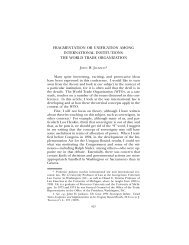some concluding remarks - Project on International Courts and ...
some concluding remarks - Project on International Courts and ...
some concluding remarks - Project on International Courts and ...
Create successful ePaper yourself
Turn your PDF publications into a flip-book with our unique Google optimized e-Paper software.
1999] CONCLUDING REMARKS 923The situati<strong>on</strong> did not change with the successi<strong>on</strong> of theInternati<strong>on</strong>al Court of Justice (ICJ) to the PCIJ after the Sec<strong>on</strong>dWorld War. An attempt was made, however, in the 1950s,by Professor Georges Scelle, to correlate arbitrati<strong>on</strong> to the ICJin his draft “Model Rules of Arbitral Procedure,” 1 which heprepared as special rapporteur of the Internati<strong>on</strong>al Law Commissi<strong>on</strong>(ILC). These Rules purported to establish a “lockingmechanism” (verouillage), whereby, <strong>on</strong>ce the parties have c<strong>on</strong>sentedto arbitrati<strong>on</strong>, every time a process reaches a deadlock,the resoluti<strong>on</strong> of the problem would ipso jure fall either to theICJ (in case of challenge of awards as ultra vires, or by requestsfor revisi<strong>on</strong> or interpretati<strong>on</strong>) or to its President (in case offailure to nominate arbitrators or their replacements). Butthis draft was heavily criticized <strong>and</strong> resisted by states, thus revealingtheir str<strong>on</strong>g preference for maintaining arbitrati<strong>on</strong> asa flexible, aut<strong>on</strong>omous procedure which, while adjudicative incharacter, remains pliable to their will throughout its course.Since the 1950s, however, in parallel with the rapidlygrowing complexity <strong>and</strong> intensity of internati<strong>on</strong>al relati<strong>on</strong>s, internati<strong>on</strong>allaw has witnessed prodigious developments, not<strong>on</strong>ly in updating its traditi<strong>on</strong>al fields, but also in exp<strong>and</strong>inginto new <strong>and</strong> more specialized <strong>on</strong>es. This has been accompaniedby a proliferati<strong>on</strong> of specialized judicial organs, <strong>on</strong> boththe universal <strong>and</strong> regi<strong>on</strong>al levels, such as administrative tribunalsof internati<strong>on</strong>al organizati<strong>on</strong>s, the Panels <strong>and</strong> Appellatebody of the World Trade Organizati<strong>on</strong> (WTO), the new Lawof the Sea Tribunal, the incipient Internati<strong>on</strong>al CriminalCourt (ICC), the European Court of Justice, regi<strong>on</strong>al tribunalsof human rights, <strong>and</strong> ad hoc tribunals such as the Internati<strong>on</strong>alCriminal Tribunals for the Former Yugoslavia (ICTY) <strong>and</strong> forRw<strong>and</strong>a (ICTR).Such specialized tribunals also exist in municipal law, butthe ambit of their specialized jurisdicti<strong>on</strong> is well delimited inrelati<strong>on</strong> to the courts of plenary or general jurisdicti<strong>on</strong>, thejurisdicti<strong>on</strong> of the latter being the rule, that of the former re-1. This draft served as a basis for the Model Rules adopted by the ILC.See Report of the Commissi<strong>on</strong> to the General Assembly, U.N. GAOR, 13th Sess.,Supp. No. 9, U.N. Doc. A/3859 (1958), reprinted in [1958] 2 Y.B. Int’l L.Comm’n 83, U.N. Doc. A/CN.4/SER.A/1958/Add.1. The General Assemblymerely “took note” of these Model Rules in Resoluti<strong>on</strong> 1262 (XIII),adopted in 1958. See G.A. Res. 1262 (XIII), U.N. GAOR, 13th Sess., Supp.No. 18, U.N. Doc. A/4090 (1958).






